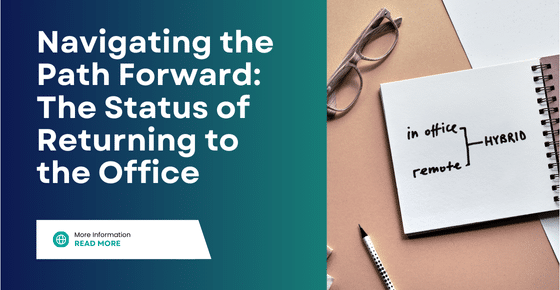Human Capital Management
Navigating the Path Forward: The Status of Returning to the Office

The workplace as we knew it has dramatically changed since 2020. The COVID-19 pandemic, along with advancements in virtual technology, has driven a significant shift towards remote work, challenging traditional notions of where and how work should be done. We’re now experiencing a tug of war between remote and in-office work. Remote work options have become an expectation for many employees rather than just a perk. Meanwhile, cities are urging employers to bring staff back to the office to support local economies through rent, taxes, and spending on restaurants, transportation, and stores. Organizations worldwide are struggling with the decision of when and how to transition employees back to the office. This shift is reshaping the future of work, emphasizing outcomes over physical presence.
The Current State:
- Employee Preferences:
- Statistics: A study by Morning Consult has found that more employees prefer a mix of remote and in-office work than remote only.
- Insight: Flexibility has become a top priority for employees, who value the autonomy to choose where they work based on personal preferences, job requirements, and work-life balance considerations.
- Return-to-Office Timelines:
- Statistics: A Resume Builder survey predicts 90% of companies with office space will have employees return to the office in some capacity by the end of 2024.
- Insight: With a significant majority of companies planning for an office return by the end of 2024, organizations are carefully managing this transition. They are implementing hybrid schedules and phased returns to balance operational needs with employee safety and well-being.
- Challenges and Considerations:
- Statistics: Flair HR reports that 40% of remote workers struggle to disconnect from work, leading to a higher burnout rate than office employees.
- Insight: As organizations navigate the return to the office, addressing employee well-being, mental health support, and maintaining a sense of community and collaboration remain critical challenges.
Balancing the Pros & Cons of Remote Work:
The debate over remote work preferences varies greatly depending on who you ask. There are numerous advantages and disadvantages to consider, and the best approach will be unique to each organization. Factors such as department, location, and individual circumstances play significant roles in determining the right balance.
Pros of Remote Work from the Employee Perspective:
- Reduced Commute Time: Eliminating the daily commute frees up time for more productive work or personal activities.
- Cost Savings: Employees can save significantly on travel and food expenses.
- Comfortable Workspace: The ability to create a personalized and comfortable working environment at home.
- Work-Life Balance: Greater flexibility to integrate work and personal life, promoting a healthier balance.
- Childcare Savings: The flexibility of remote work can lead to potential reductions in childcare costs.
Cons of Remote Work from the Employee Perspective:
- Isolation: Remote work can lead to feelings of isolation, increasing the risk of depression and anxiety.
- Learning Opportunities: A decrease in collaborative learning and live observation opportunities.
- Difficulty Unplugging: Challenges in separating work from personal life, leading to trouble unplugging.
- Health Concerns: More sedentary environments can contribute to health issues.
- Visibility and Promotion: Challenges in building relationships and visibility can impact career advancement. According to Live Data Technologies, fully remote workers were promoted 31% less frequently than their in-person peers last year.
Pros of Remote Work from the Employer Perspective:
- Cost Savings: Lower expenses related to office space and overhead.
- Expanded Talent Pool: The ability to hire from a larger, more geographically diverse pool of candidates.
- Competitive Advantage: Offering remote work can be a significant edge in attracting and retaining talent.
- Employee Well-being: Improved health and well-being can lead to happier, more productive employees.
- Business Continuity: Enhanced ability to scale operations up or down quickly as needed.
Cons of Remote Work from the Employer Perspective:
- Collaboration and Communication: Maintaining team cohesion and culture can be more challenging.
- Productivity Management: Tracking productivity and ensuring accountability without physical oversight.
- Data Security: Increased complexity in ensuring data security and compliance.
- Inequities: Potential disparities in access to resources, visibility, and promotion opportunities.
- Onboarding and Development: Greater difficulties in effectively onboarding new hires and developing current staff.
While remote work offers numerous benefits, these challenges highlight the importance of strategic planning and implementation to see what will be best for your workforce. If employers decide to have a hybrid or remote structure, they must balance remote work with in-person interactions, invest in technology and training, and foster a supportive and inclusive culture to mitigate potential downsides. However, this won’t work for all organizations. The journey back to the office is a nuanced one, shaped by evolving circumstances, employee preferences, and organizational priorities. While the office remains an important hub for collaboration, innovation, and culture, the future of work is undeniably hybrid. As we move forward, it is essential for employers to listen to their workforce, adapt to changing dynamics, and embrace flexibility as a cornerstone of the modern workplace.
Recommendations for Companies Handling Employees Returning to the Office:
- Assess the Team(s):
- The Work: Determine the nature of the work and whether it can be performed remotely. Identify key business objectives.
- Trust: Evaluate the level of trust within the company culture, considering each team individually.
- Implement a Hybrid Work Model:
- Flexibility: Allow employees to split their time between the office and remote work based on their roles and preferences.
- Tech Infrastructure: Invest in robust technology solutions to support seamless collaboration between in-office and remote team members.
- Offer Flexible Scheduling:
- Staggered Shifts: Introduce staggered working hours to allow for employees to balance commute times, childcare and well-being. Thanks to technology, a lot of roles don’t require a strict 9 to 5.
- Compressed Workweeks: Allow employees to work longer hours over fewer days, if possible, to give them more flexibility.
- Communicate Transparently:
- Regular Updates: Keep employees informed about company policies, health guidelines, and changes in office protocols.
- Feedback Mechanisms: Create channels for employees to share their concerns and suggestions regarding the return to the office.
- Support Employee Well-being:
- Mental Health Resources: Provide access to mental health services, such as counseling and stress management programs.
- Work-Life Balance: Encourage employees to take breaks and vacations to avoid burnout.
- Reimagine Office Space:
- Collaboration Zones: Designate areas specifically for team meetings and collaborative work.
- Quiet Spaces: Create quiet zones for focused, individual work to accommodate different working styles.
- Foster a Culture of Inclusivity:
- Equal Opportunities: Ensure that remote employees have the same access to opportunities and resources as those in the office.
- Team Building: Organize virtual and in-person team-building activities to maintain a strong sense of community.
- Invest in Training and Development:
- Skill Enhancement: Offer training programs to help employees adapt to new technologies and workflows.
- Leadership Development: Equip managers with the skills to lead hybrid teams effectively.
- Monitor and Adjust:
- Performance Metrics: Track productivity and employee satisfaction to gauge the effectiveness of return-to-office strategies.
- Continuous Improvement: Be willing to adjust policies and practices based on feedback and changing circumstances.
- Leverage Technology:
- Collaboration Tools: Utilize video conferencing, project management software, and other digital tools to facilitate communication and collaboration.
- Cloud Solutions: Ensure data and resources are accessible from anywhere to support remote work.
By implementing these recommendations, companies can create a flexible, safe, and supportive work environment that not only facilitates the return to the office but also enhances overall competitiveness and employee satisfaction. The aim is to integrate the best aspects of both in-person collaboration and remote work flexibility.
Recognizing that one size does not fit all, each organization must assess its specific needs, adaptability, and employee feedback to develop a plan that balances a positive employee experience with business objectives.
This evolving workplace model differs significantly from just five years ago and will likely continue to change. The key for companies is to continually assess and adjust to meet both business and employee needs. Embracing flexibility and adaptability will be crucial as technology advances and continues to reshape our workspaces.
Exude Human Capital Consulting is not your typical consulting firm. Since our founding in 2006, we’ve been on a mission to transform organizations by connecting the dots between Human Resources, Leadership Development, and Inclusion & Belonging. We provide dynamic solutions in HR outsourcing, compensation strategies, strategic advisory, organizational and cultural assessments, DEIB advisory and training, coaching, and leadership development programs.
At Exude, we understand that people are the cornerstone of every successful organization. We’re dedicated to helping organizations—big, small, and everything in between—lift up their people, their mission, and their bottom line. Our equitable perspectives create an environment where teams can truly shine and grow, and individuals feel a deep sense of belonging. Our diverse team of talented consultants is committed to delivering impactful, tailored strategies that align with your goals and values.
Start a conversation today to see how we can help with your people goals.










